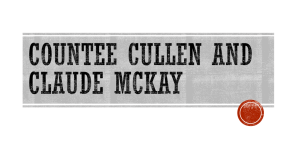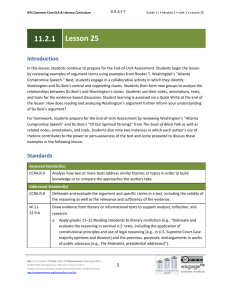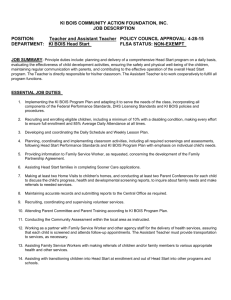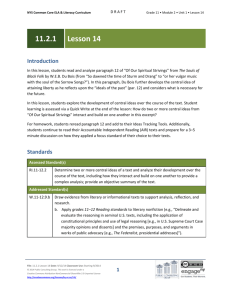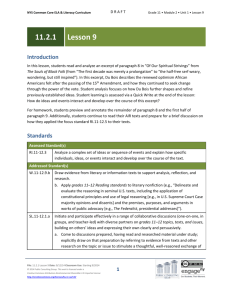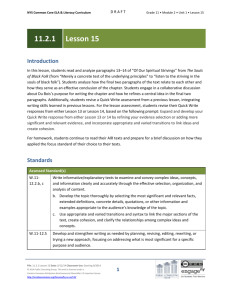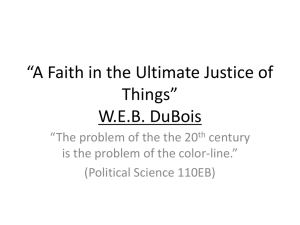Grade 11 ELA Module 2, Unit 1, Lesson 4
advertisement
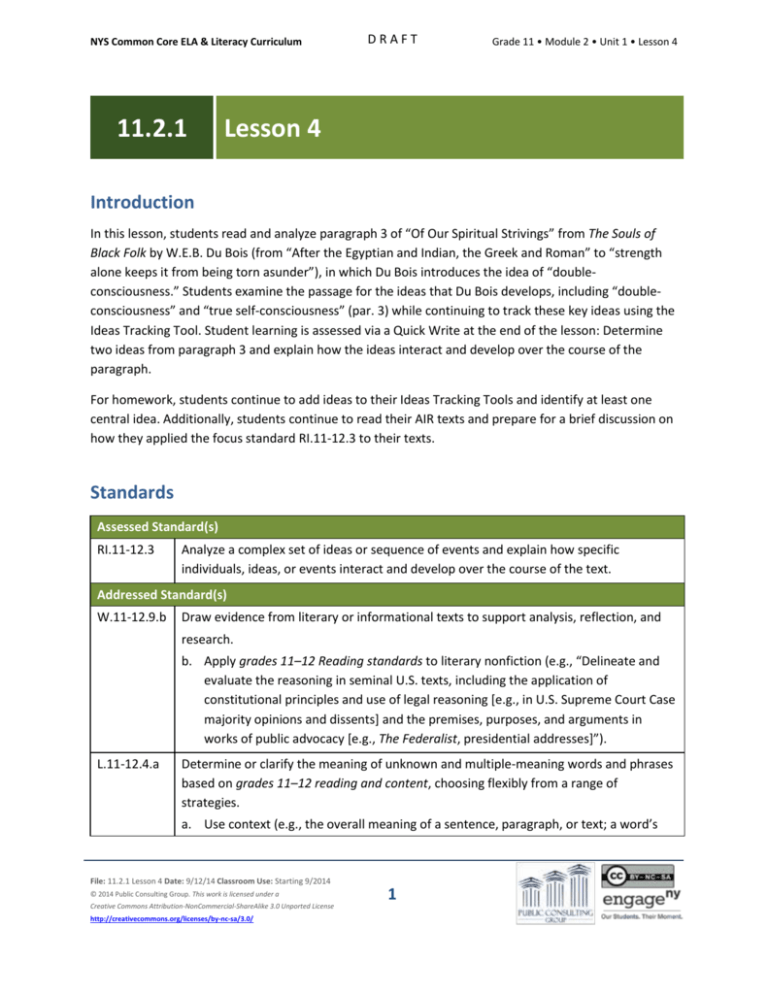
NYS Common Core ELA & Literacy Curriculum 11.2.1 DRAFT Grade 11 • Module 2 • Unit 1 • Lesson 4 Lesson 4 Introduction In this lesson, students read and analyze paragraph 3 of “Of Our Spiritual Strivings” from The Souls of Black Folk by W.E.B. Du Bois (from “After the Egyptian and Indian, the Greek and Roman” to “strength alone keeps it from being torn asunder”), in which Du Bois introduces the idea of “doubleconsciousness.” Students examine the passage for the ideas that Du Bois develops, including “doubleconsciousness” and “true self-consciousness” (par. 3) while continuing to track these key ideas using the Ideas Tracking Tool. Student learning is assessed via a Quick Write at the end of the lesson: Determine two ideas from paragraph 3 and explain how the ideas interact and develop over the course of the paragraph. For homework, students continue to add ideas to their Ideas Tracking Tools and identify at least one central idea. Additionally, students continue to read their AIR texts and prepare for a brief discussion on how they applied the focus standard RI.11-12.3 to their texts. Standards Assessed Standard(s) RI.11-12.3 Analyze a complex set of ideas or sequence of events and explain how specific individuals, ideas, or events interact and develop over the course of the text. Addressed Standard(s) W.11-12.9.b Draw evidence from literary or informational texts to support analysis, reflection, and research. b. Apply grades 11–12 Reading standards to literary nonfiction (e.g., “Delineate and evaluate the reasoning in seminal U.S. texts, including the application of constitutional principles and use of legal reasoning [e.g., in U.S. Supreme Court Case majority opinions and dissents] and the premises, purposes, and arguments in works of public advocacy [e.g., The Federalist, presidential addresses]”). L.11-12.4.a Determine or clarify the meaning of unknown and multiple-meaning words and phrases based on grades 11–12 reading and content, choosing flexibly from a range of strategies. a. Use context (e.g., the overall meaning of a sentence, paragraph, or text; a word’s File: 11.2.1 Lesson 4 Date: 9/12/14 Classroom Use: Starting 9/2014 © 2014 Public Consulting Group. This work is licensed under a Creative Commons Attribution-NonCommercial-ShareAlike 3.0 Unported License http://creativecommons.org/licenses/by-nc-sa/3.0/ 1 NYS Common Core ELA & Literacy Curriculum DRAFT Grade 11 • Module 2 • Unit 1 • Lesson 4 position or function in a sentence) as a clue to the meaning of a word or phrase. Assessment Assessment(s) Student learning is assessed via a Quick Write at the end of the lesson. Students respond to the following prompt, citing textual evidence to support analysis and inferences drawn from the text. Determine two ideas from paragraph 3 and explain how the ideas interact and develop over the course of the paragraph. High Performance Response(s) A High Performance Response should: Determine two ideas from paragraph 3 (e.g., double-consciousness and true self-consciousness). Explain how the two ideas interact and develop (e.g., The ideas of “double-consciousness” and “true self-consciousness” (par. 3) are in opposition to each other, because double-consciousness prevents African Americans from achieving “true self-consciousness” (par. 3). Du Bois explains that African Americans cannot have “true self-consciousness” (par. 3), or the ability to know themselves through their own eyes, because they can only see themselves through “the eyes of others” (par. 3). Du Bois constructs the idea of “true self-consciousness” (par. 3) as the honest and positive experience of understanding one’s own self-worth that Africans Americans are denied; “doubleconsciousness” (par. 3) forces African Americans to see themselves through the “other world[’s]” (par. 3) perspective of difference and hatred.). Vocabulary Vocabulary to provide directly (will not include extended instruction) unreconciled (adj.) – not brought into agreement or harmony ideals (n.) – ultimate objects or aims of endeavor, especially ones of high or noble character dogged (adj.) – having or showing the attitude of a person who wants to do or get something and will not stop trying asunder (adv.) – into separate parts; in or into pieces Vocabulary to teach (may include direct word work and/or questions) yields (v.) – produces or provides self-consciousness (n.) – aware of oneself or one’s own being File: 11.2.1 Lesson 4 Date: 9/12/14 Classroom Use: Starting 9/2014 © 2014 Public Consulting Group. This work is licensed under a Creative Commons Attribution-NonCommercial-ShareAlike 3.0 Unported License http://creativecommons.org/licenses/by-nc-sa/3.0/ 2 NYS Common Core ELA & Literacy Curriculum DRAFT Grade 11 • Module 2 • Unit 1 • Lesson 4 Additional vocabulary to support English Language Learners (to provide directly) sense (n.) – a particular feeling; an emotion that you are aware of Lesson Agenda/Overview Student-Facing Agenda % of Lesson Standards & Text: Standards: RI.11-12.3, W.11-12.9.b, L.11-12.4.a Text: The Souls of Black Folk by W.E.B. Du Bois, Chapter 1: “Of Our Spiritual Strivings,” paragraph 3 Learning Sequence: 1. 2. 3. 4. 5. 6. Introduction of Lesson Agenda Homework Accountability Masterful Reading Reading and Discussion Quick Write Closing 1. 2. 3. 4. 5. 6. 5% 10% 5% 60% 15% 5% Materials Student copies of the Short Response Rubric and Checklist (refer to 11.2.1 Lesson 1) Student copies of the Ideas Tracking Tool (refer to 11.2.1 Lesson 2)—students may need additional blank copies Learning Sequence How to Use the Learning Sequence Symbol Type of Text & Interpretation of the Symbol 10% no symbol Percentage indicates the percentage of lesson time each activity should take. Plain text indicates teacher action. Bold text indicates questions for the teacher to ask students. Italicized text indicates a vocabulary word. Indicates student action(s). Indicates possible student response(s) to teacher questions. Indicates instructional notes for the teacher. File: 11.2.1 Lesson 4 Date: 9/12/14 Classroom Use: Starting 9/2014 © 2014 Public Consulting Group. This work is licensed under a Creative Commons Attribution-NonCommercial-ShareAlike 3.0 Unported License http://creativecommons.org/licenses/by-nc-sa/3.0/ 3 NYS Common Core ELA & Literacy Curriculum DRAFT Grade 11 • Module 2 • Unit 1 • Lesson 4 Activity 1: Introduction of Lesson Agenda 5% Begin by reviewing the agenda and the assessed standard for this lesson: RI.11-12.3. In this lesson, students read and discuss paragraph 3 of “Of Our Spiritual Strivings,” focusing on how Du Bois introduces and develops key ideas in this passage. Students look at the agenda. Activity 2: Homework Accountability 10% Instruct students to talk in pairs about how they applied the focus standard RI.11-12.3 to their AIR texts. Lead a brief share out on the previous lesson’s AIR homework assignment. Select several students (or student pairs) to explain how they applied the focus standard to their AIR texts. Students (or student pairs) discuss and share how they applied the focus standard to their AIR texts from the previous lesson’s homework. Instruct students to take out their responses to Lesson 3’s homework assignment. (Reread paragraph 2 (from “I had thereafter no desire to tear down” to “watch the streak of blue above”) and add at least one new idea to your Ideas Tracking Tool.) Instruct students to talk in pairs about the additions they made to their Ideas Tracking Tools. See Model Ideas Tracking Tool at the end of this lesson. Activity 3: Masterful Reading 5% Have students listen to a masterful reading of paragraph 3 of “Of Our Spiritual Strivings” by W.E.B. Du Bois (from “After the Egyptian and Indian, the Greek and Roman” to “strength alone keeps it from being torn asunder”). Instruct students to follow along in their texts and focus on the introduction of new ideas. Students follow along, reading silently. Differentiation Consideration: Consider posting or projecting the following guiding question to support students in their reading throughout this lesson: What are two new ideas that Du Bois introduces in this paragraph? File: 11.2.1 Lesson 4 Date: 9/12/14 Classroom Use: Starting 9/2014 © 2014 Public Consulting Group. This work is licensed under a Creative Commons Attribution-NonCommercial-ShareAlike 3.0 Unported License http://creativecommons.org/licenses/by-nc-sa/3.0/ 4 NYS Common Core ELA & Literacy Curriculum DRAFT Grade 11 • Module 2 • Unit 1 • Lesson 4 Activity 4: Reading and Discussion 60% Instruct students to form small groups. Post or project each set of questions below for students to discuss. Instruct students to continue to annotate the text as they read and discuss. Instruct student groups to read the first sentence of paragraph 3 (from “After the Egyptian and Indian, the Greek and Roman” to “through the revelation of the other world”) and answer the following questions before sharing out with the class. Instruct students to revise or add to their annotation as they analyze the text. This focused annotation supports students’ engagement with W.11-12.9.b, which addresses the use of textual evidence in writing. What does Du Bois list in the first sentence of paragraph 3? Du Bois lists different historical races or cultures from all over the world, such as “the Egyptian” and “the Greek.” What is the effect of beginning the sentence with “[a]fter”? Student responses may include: o o By using the word “[a]fter” to begin the sentence, Du Bois suggests that African Americans follow, or are connected to, these other ethnic groups. Du Bois’s use of “[a]fter” implies that African Americans have less value or possess less power than the other ethnic groups, since they are “seventh” in line of historical races or cultures. How does the phrase “born with a veil” (par. 3) further develop the idea of the “veil” (par. 2) from previous paragraphs? Student responses may include: o o The phrase “born with a veil” (par. 3) develops Du Bois’s metaphor for the exclusion of African Americans, because it reveals that this separation is not a choice or something that African Americans can avoid. The phrase “born with a veil” (par. 3) develops the idea that just as Du Bois is unable to escape the experience of being viewed as “a problem” (par. 1), the “veil” (par. 3) is a separation forced upon all African Americans by the white world from the moment they are born because of their skin color. How does the “American world” treat African Americans? File: 11.2.1 Lesson 4 Date: 9/12/14 Classroom Use: Starting 9/2014 © 2014 Public Consulting Group. This work is licensed under a Creative Commons Attribution-NonCommercial-ShareAlike 3.0 Unported License http://creativecommons.org/licenses/by-nc-sa/3.0/ 5 NYS Common Core ELA & Literacy Curriculum DRAFT Grade 11 • Module 2 • Unit 1 • Lesson 4 Du Bois explains that America does not allow African Americans to develop “true selfconsciousness” because they are forced to see themselves through the lens “of the other world,” which excludes them and highlights their difference. Differentiation Consideration: If students struggle with this analysis, consider posing the following scaffolding questions: How does the order of words in the sentence beginning “After the Egyptian and Indian” (par. 3) help you to make meaning of yields in this context? Du Bois’s use of “lets” following “but” suggests that yields and lets mean similar things (par. 3). Therefore, yields means gives or provides. Consider drawing students’ attention to their work with L.11-12.4.a as they use context clues to determine the meaning of a word. What is the role of the dash in this sentence? The dash functions like a colon. Du Bois uses the text following the dash to explain what comes before it. Thus, Du Bois describes “this American world” as “a world which yields [African Americans] no true self-consciousness, but only lets [them] see [themselves] through the revelation of the other world.” Turn-and-Talk with a peer about what the term “true self-consciousness” means in this sentence. Use the context of the passage to determine meaning. “True self-consciousness” is something African Americans do not have because they are forced to see themselves through the eyes of white people. Therefore, “true self-consciousness” describes a state in which African Americans are able to know themselves on their own terms rather than the white world’s terms. Differentiation Consideration: If students struggle with the question above, consider providing the following definition: self-consciousness means “being aware of one’s self or one’s being.” Consider drawing students’ attention to their work with L.11-12.4.a as they use context clues to determine the meaning of a phrase. Lead a brief whole-class discussion of student responses. Instruct student groups to read the second sentence in paragraph 3 (from “It is a peculiar sensation, this double-consciousness” to “amused contempt and pity”) and answer the following questions before sharing out with the class. File: 11.2.1 Lesson 4 Date: 9/12/14 Classroom Use: Starting 9/2014 © 2014 Public Consulting Group. This work is licensed under a Creative Commons Attribution-NonCommercial-ShareAlike 3.0 Unported License http://creativecommons.org/licenses/by-nc-sa/3.0/ 6 NYS Common Core ELA & Literacy Curriculum DRAFT Grade 11 • Module 2 • Unit 1 • Lesson 4 Differentiation Consideration: Provide students with the following definition: sense means “a particular feeling; an emotion that you are aware of.” Students write the definition of sense on their copies of the text or in a vocabulary journal. How does Du Bois use figurative language to develop the idea of “double-consciousness”? Du Bois uses the metaphor of “measuring one’s soul” with a measuring “tape” made by those who “look[] on in amused contempt and pity” to explain that the tools or benchmarks that African Americans use to evaluate themselves have been shaped by the perspective of people who treat them disrespectfully and feel sorry for them. This metaphor suggests that African Americans experience “double-consciousness” because they are forced to analyze their worth as human beings based upon standards set by people who feel that they have little worth. Differentiation Consideration: If students struggle with this analysis, consider posing the following scaffolding question: How does Du Bois define “double-consciousness”? Du Bois defines the feeling of double-consciousness as strange, “a peculiar sensation” and as the “sense” of always looking at one’s self through the viewpoint of someone else. If students struggle with this metaphor, consider clarifying that “tape” in this context refers to a measuring tape. Lead a brief whole-class discussion of student responses. Instruct student groups to read the last sentence in paragraph 3 (from “One ever feels his twoness,—an American, a Negro” to “being torn asunder”) and answer the following questions before sharing out with the class. Provide students with the following definitions: unreconciled means “not brought into agreement or harmony,” ideals means “ultimate objects or aims of endeavor, especially ones of high or noble character,” dogged means “having or showing the attitude of a person who wants to do or get something and will not stop trying,” and asunder means “into separate parts; in or into pieces.” Students may be familiar with some of these words. Consider asking students to volunteer definitions before providing them to the class. Students write the definitions of unreconciled, ideals, dogged, and asunder on their copies of the text or in a vocabulary journal. What is the “twoness” Du Bois describes? File: 11.2.1 Lesson 4 Date: 9/12/14 Classroom Use: Starting 9/2014 © 2014 Public Consulting Group. This work is licensed under a Creative Commons Attribution-NonCommercial-ShareAlike 3.0 Unported License http://creativecommons.org/licenses/by-nc-sa/3.0/ 7 NYS Common Core ELA & Literacy Curriculum DRAFT Grade 11 • Module 2 • Unit 1 • Lesson 4 “Twoness” is the feeling that African Americans experience as the result of possessing two identities as “an American” and as “a Negro.” What does Du Bois mean by “two warring ideals”? How does the use of the word warring refine Du Bois’s description of the ideals? The “two warring ideals” are the conflicting “American” and “Negro” strivings that African Americans experience. Du Bois also refers to these “two warring ideals” as “two souls, two thoughts, two unreconciled strivings.” By writing that the “ideals” are “warring,” Du Bois implies that they are in conflict with each other. Where are the “ideals” “warring”? What does this description suggest about the effect of the feeling of twoness on African Americans? The ideals are warring “in one dark body,” which means that the conflict is an internal one. Du Bois writes that the body’s “dogged strength alone keeps it from being torn asunder.” This implies that “twoness” is an extremely damaging and negative feeling for African Americans because there is internal conflict that almost tears them apart. How does the idea of “twoness” further develop the idea of “double-consciousness”? The idea of “twoness” develops the idea of “double-consciousness,” because it explains what happens when African Americans are forced to always see themselves “through the eyes of others.” Because the way “the other world” sees them does not match how they see themselves, African Americans feel a sense of “twoness” or the feeling of being two different and “warring” or “unreconciled” people at once. How does the metaphor of the “veil” relate to “twoness” and “double-consciousness”? The ideas of the “veil,” “twoness,” and “double-consciousness” all work together to develop the idea that African Americans are forced into a painful world of duality and opposition. The “veil” is a metaphor for the separation and exclusion of African Americans from the rest of the “American world.” As a result of this exclusion, African Americans are forced into a state of “double-consciousness,” because they see themselves in two different ways: through their eyes and the eyes of a white world that “looks on in contempt and pity.” This causes African Americans to feel internal strife, or a feeling of conflicting “twoness,” because the “American” part of themselves is “warring” with the “Negro” part. Lead a brief whole-class discussion of student responses. File: 11.2.1 Lesson 4 Date: 9/12/14 Classroom Use: Starting 9/2014 © 2014 Public Consulting Group. This work is licensed under a Creative Commons Attribution-NonCommercial-ShareAlike 3.0 Unported License http://creativecommons.org/licenses/by-nc-sa/3.0/ 8 NYS Common Core ELA & Literacy Curriculum DRAFT Grade 11 • Module 2 • Unit 1 • Lesson 4 Activity 5: Quick Write 15% Instruct students to respond briefly in writing to the following prompt: Determine two ideas from paragraph 3 and explain how the ideas interact and develop over the course of the paragraph. Instruct students to look at their annotations and their Ideas Tracking Tools to find evidence. Ask students to use this lesson’s vocabulary wherever possible in their written responses. Remind students to use the Short Response Rubric and Checklist to guide their written responses. Students listen and read the Quick Write prompt. Display the prompt for students to see, or provide the prompt in hard copy. Transition to the independent Quick Write. Students independently answer the prompt using evidence from the text. See the High Performance Response at the beginning of this lesson. Activity 6: Closing 5% Display and distribute the homework assignment. For homework, instruct students to add at least one idea to their Ideas Tracking Tools and identify at least one central idea. Also for homework, students should continue to read their AIR text through the lens of the focus standard RI.11-12.3 and prepare for a 3–5 minute discussion of their text based on that standard. Students follow along. Students who are reading literature should read through the lens of a focus standard of their choice. Homework Add at least one idea to your Ideas Tracking Tool and identify at least one central idea. Also, continue reading your AIR text through the lens of the focus standard RI.11-12.3 and prepare for a 3–5 minute discussion of your text based on that standard. File: 11.2.1 Lesson 4 Date: 9/12/14 Classroom Use: Starting 9/2014 © 2014 Public Consulting Group. This work is licensed under a Creative Commons Attribution-NonCommercial-ShareAlike 3.0 Unported License http://creativecommons.org/licenses/by-nc-sa/3.0/ 9 DRAFT NYS Common Core ELA & Literacy Curriculum Grade 11 • Module 2 • Unit 1 • Lesson 4 Model Ideas Tracking Tool Name: Class: Date: Directions: Identify the ideas that you encounter throughout the text. Trace the development of those ideas by noting how the author introduces, develops, or refines these ideas in the texts. Cite textual evidence to support your work. Text: “Of Our Spiritual Strivings” from The Souls of Black Folk by W.E.B. Du Bois Paragraph # Ideas Notes and Connections 2 African Americans are shut out from “the other world” (par. 1) by a “vast veil” (par. 2). This refers to the idea that Du Bois and other African Americans are separate or excluded from the white world because of their skin color. 2 America feels like a “prisonhouse” (par. 2) for Du Bois and other African Americans. Du Bois connects the “prison-house” to the “veil” (par. 2) and “the other world” (par. 1) by saying that African Americans had little or no hope of ever attaining the opportunities on the other side of the “wall” (par. 2), or in America, because white Americans keep them away from these chances. File: 11.2.1 Lesson 4 Date: 9/12/14 Classroom Use: Starting 9/2014 © 2014 Public Consulting Group. This work is licensed under a Creative Commons Attribution-NonCommercial-ShareAlike 3.0 Unported License http://creativecommons.org/licenses/by-nc-sa/3.0/ 10

